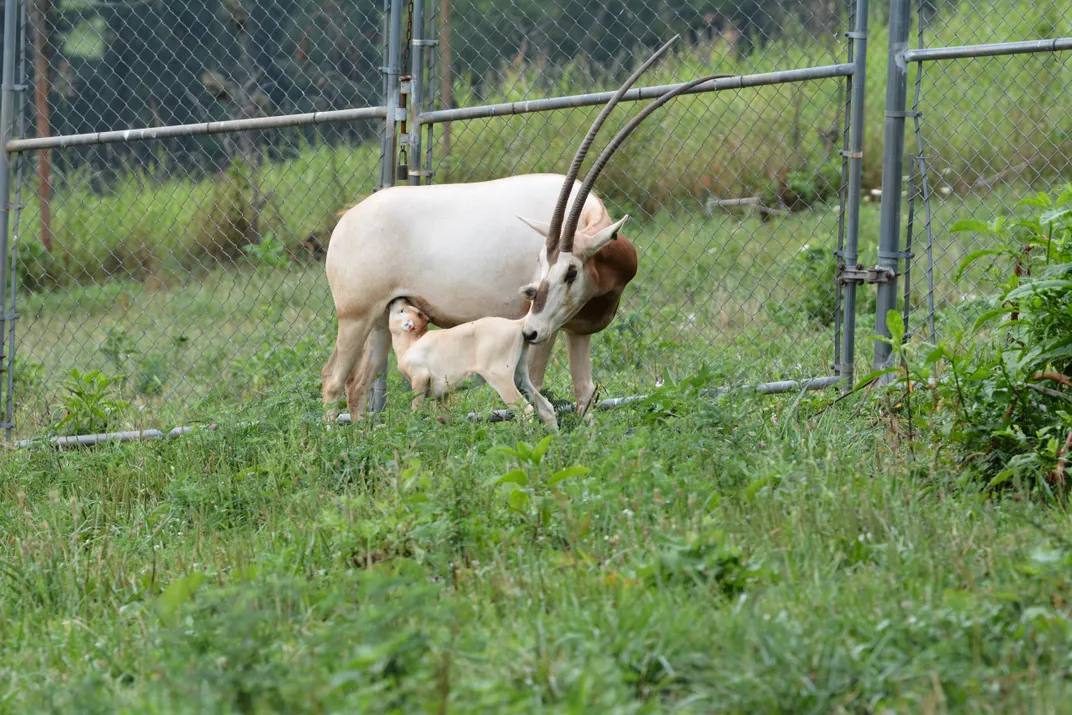Two New Scimitar-Horned Oryx Calves Born Through Improved Methods of Artificial Insemination
The assisted reproduction method will help with population management efforts of these critically endangered species and their rewilding
/https://tf-cmsv2-smithsonianmag-media.s3.amazonaws.com/filer/d5/38/d5382e0c-d669-4c12-b6f1-d883a5ea06f0/20210720-budhanpukazhenthi-010_resize.jpg)
Last month, the Smithsonian Conservation Biology Institute (SCBI) in Front Royal, Virginia, celebrated the births of two scimitar-horned oryx calves, a male and a female, following artificial insemination of their mothers. The healthy newborns not only add to the numbers of the critically endangered species, but they also validate the efforts of researchers to hone a new assisted reproduction technique that may prove crucial in the ongoing initiatives to reintroduce these animals into the wild.
The recent births at SCBI are thanks to an insemination protocol that was first developed in the 1990s and gradually improved upon over the years. Six-year-old Esmerelda delivered a male calf on July 9 and the next day, a female calf was born to the five-year-old female, Leanne.
In 2000, SCBI carried out their first artificial insemination procedure in scimitar-horned oryxes, featuring an injection sequence of a cocktail of hormones prior to impregnation. Intended for maximizing the chances of a successful pregnancy, these hormone concoctions were adapted from a recipe that was originally used for impregnating cattle.
Later innovations to the assisted reproduction technique arose when SCBI researchers devised a way to impregnate females without the use of anesthesia, which could interfere with the ovulation cycle. The researchers’ workaround was to use a hydraulic restraining device that would keep a female oryx still enough—and gently—for researchers to inject or inseminate her. Using the contraption was no straightforward task. The researchers first had to familiarize the females with the device—a process that could take several weeks to months. In 2018, SCBI welcomed the birth of an oryx calf from the first anesthesia-free assisted reproduction procedure.
The latest advance in SCBI’s technique is a revised hormone injection schedule that improves upon the timing of insemination. The researchers have managed to narrow the insemination window of the female, boosting the chances for the oryx sperm to fertilize the egg in her body.
“When we don't have any information on where [oryx females] are in their reproductive cycle, timing the artificial insemination becomes the challenge,” says Budhan Pukazhenthi, a reproductive physiologist at SCBI. “What we are able to do is to inject certain hormones to these animals to reset their reproductive cycles and start a new one.”
To prepare the females for fertilization, Pukazhenthi’s team injected them with three separate doses of hormones beforehand. The first dose contains the gonadotropin-releasing hormone that resets the ovulation cycle of the female. Seven days after, the researchers injected prostaglandin to initiate a new run and get her into heat. On the ninth day, the researchers administered a last dose of the first hormone to induce ovulation and also delivered the male sperm to her uterus. Esmerelda and Leanne were inseminated with previously frozen sperm that were collected 20 and 13 years ago.
The researchers carried out the entirety of their procedure on nine females around the end of last October; about eight months later, the two healthy calves were born. Yet to be named, the calves are bonding with their mothers and well on their way integrating with the rest of the herd.

These ungulates once roamed the North African drylands in herds of up to 70 members strong. They boast a hardy constitution—staying cool was literally no sweat to them. By conserving their sweat, they require little water to survive; so that oryxes can tolerate the extreme desert heat that would kill off most other mammals. Their white hides, along with the systems of blood vessels that run close to the skin's surface, help keep their bodies cooler under the hot sun.
Although oryxes have long endured, over millions of years, the common threats of droughts and predators, they are no match against human incursions. Overhunted for their horns and hides, and faced with the loss of their habitats, their numbers began to dwindle in early- and mid-20th century. The last free-roaming oryx was observed in 1988; by 2000, the International Union for Conservation of Nature had officially declared them extinct in wild.
Fortunately, zoos and private keepers rescued several before their species disappeared, then seeded captive breeding programs with these individuals. Today, these conservation efforts have paid off. The largest captive herd boasts around 3,000 members and resides in Abu Dhabi in the United Arab Emirates (UAE). After years of exile, the first group of 25 foreign-bred oryxes were airlifted to their motherland in Chad in 2016 and released in the wild.
Over the years, thanks to a collaboration of the Abu Dhabi’s Environmental Agency, the Sahara Conservation Fund, the Zoological Society of London and SCBI, the numbers in Chad have soared to nearly 150. The eventual goal is to rewild a total of 500 of these animals by next year.
Captive breeding programs are crucial to the success of ongoing reintroduction initiatives of these long-lost species. Still, participating animal keepers have to take care to uphold the genetic diversity of their herds as new generations are bred. Inbreeding reduces the ability of oryxes as a species to adapt to new environmental challenges such as diseases in the future.
Artificial insemination is crucial for achieving this goal, as it can make use of stored or exchanged genetic material from oryx individuals who lived at a different time and place. Researchers save and freeze the semen of genetically strapping males long after they pass. Years and generations of oryxes later, the researchers take the historical sperm out of storage and artificially inseminate current female oryxes. Animal keepers around the world may also share genetic material with other breeders to further spruce up the gene pool in the next cohort of calves.
This assisted reproduction technique will also be valuable for reducing the number of oryxes to be transported during rewilding. Frozen sperm is easier to ferry than live animals, and new calves can be borne from females without the need for male participation. (Imagine Noah’s Ark carrying just the females and scores of sperm from their male counterparts, and that Noah was also a veterinarian—the Ark would have been a lot smaller and lighter.)

Pukazhenthi occasionally walks past the pastures where the newborns dwell. Among the two youngsters, he notices that the male calf is the more adventurous one, curiously and steadily holding the gaze of this unfamiliar vet who in fact orchestrated his entire conception.
Pukazhenthi acknowledges that artificial insemination doesn’t always result in a pregnancy. His most recent success rate of two out of nine—about 20 percent—is decent, and he hopes to reach 30 for 40 percent in the future. His team already has a plan going forward. During and after the insemination process, the researchers monitored the hormone data from the fecal samples of the females who underwent the fertilization treatment. They will layer this information onto the pregnancy outcome and revise the injection protocol wherever necessary. They will play around with the timing of the insemination—even delaying or bringing forward this step by a day might make a significant difference.
Eventually, Pukazhenthi aims to come up with a standard oryx insemination procedure with the highest chance of pregnancy success. The goal is to do away with the daily monitoring of the females and bypass the need to customize their insemination schedules, as such a process would be too labor intensive to be practical. “What we're trying to accomplish is to keep it as straightforward and simple as possible,” he says.
In the near future, he hopes to contribute his artificial insemination protocol to the rewilding efforts. More specifically, he hopes that his method can be used to pre-emptively impregnate females with fresh, new genetic material before they are released in the wild.
/https://tf-cmsv2-smithsonianmag-media.s3.amazonaws.com/accounts/headshot/kim.png)
/https://tf-cmsv2-smithsonianmag-media.s3.amazonaws.com/accounts/headshot/kim.png)